Free Download: Sales Plan Template
In my experience, everyone — from the top to the bottom of a sales org — benefits from having solid, actionable, thoughtfully-organized sales plans.
But putting together a sales plan isn’t always straightforward. It can be kind of complicated; involves tons of steps. But there is good news: you don’t have to make a sales plan with zero help. To guide you through this partly-intense process, I’ve assembled this detailed blog post that reviews everything you should know about sales planning (and will ensure your next sales plan is practical, produces results that you want to see, and detail-oriented).
Table of Contents:
- What is a sales plan?
- Sales Planning Process
- Importance of the Sales Planning Process
- What goes in a sales plan template?
- How to Write a Sales Plan
- How to Write a Sales Plan
- Tips for Creating an Effective Sales Plan
- Types of Sales Plans
- Strategic Sales Plan Examples
- Create a Sales Plan That Grows With Your Business
What is a sales plan?
A sales plan outlines your objectives, high-level tactics, target audience, and potential obstacles. It’s like a traditional business plan that focuses on your sales strategy. A business plan lays out your goals — a sales plan describes precisely how you’ll make those happen.
Sales plans often include information about the business’s target customers, revenue goals, team structure, and the strategies and resources necessary for achieving its targets.

Free Sales Plan Template
Outline your company's sales strategy in one simple, coherent sales plan.
- Target Market
- Prospecting Strategy
- Budget
- Goals
Download Free
All fields are required.

What are the goals of an effective sales plan?
The purpose of your company’s sales plan is to:
- Communicate company goals and objectives
- Provide strategic direction
- Outline roles and responsibilities
- Monitor your sales team’s progress
1. Communicate your company’s goals and objectives.
Goals and objectives are the lifeblood of successful sales efforts. You can’t know what you’re working for or whether you‘ve achieved anything meaningful if you don’t have them in place.
Your sales reps need a solid sense of what’s expected of them. You can’t go to your team and just say, “Sell.” In my experience, you have to establish clear, practical, and ambitious benchmarks.
And if — or more likely when — those goals change over time, you need to regularly communicate those shifts and the strategic adjustments that come with them to your team.
2. Provide strategic direction.
Your sales strategy keeps your sales process productive. It offers actionable steps your reps can take to deliver on your vision and realize the goals you set. So naturally, you need to communicate it effectively. A sales plan offers a solid resource for that.
For instance, your sales org might notice your SDRs are posting lackluster cold call conversion rates. In turn, they should focus primarily on email outreach. Or you could experiment with new sales messaging on calls. Or you could test a multi-channel approach by incorporating social media outreach and personalized video sales letters.
There’s many approaches to take, but here’s the core of my advice: Don’t force it. Do what feels most organic for you and your sales team. Regardless of how you want to approach the situation, a thoughtfully structured sales plan gives both you and your reps a high-level perspective that would inform more cohesive, authentic team efforts.
3. Outline roles and responsibilities.
An effective sales org is a machine, where each part has a specific function that serves a specific purpose that needs to be executed in a specific fashion. Everyone who comprises that org needs to have a clear understanding of how they specifically play into the company’s broader sales strategy.
In my opinion, outlining roles and responsibilities while sales planning lends itself to more efficient task delegation, overlap reduction, and increased accountability. All of which amount to more streamlined, successful sales efforts.
4. Monitor your sales team's progress.
Sales planning sets the framework for gauging how well your team delivers on your sales strategy. It informs the benchmarks and milestones reps use to see how their performance compares to your goals and expectations.
I’ve also found it gives sales leadership a holistic view of how well a sales org is functioning, giving them the necessary perspective to understand whether they have the right people and tools to thrive.
Sales Planning Process
Sales planning isn’t (and shouldn’t) be limited to the actual sales plan document it produces. If that document has any substance or practical value, it should be the byproduct of a thorough, well-informed, high-level strategy.
In my experience, there are some key steps you need to cover when planning sales. These include:
- Gathering sales data and searching for trends
- Defining your objectives
- Determining metrics for success
- Assessing the current situation
- Starting sales forecasting
- Identifying gaps
- Ideating new initiatives
- Involving stakeholders
- Outlining action items
When putting this list together, I tapped Zach Drollinger, Senior Director of Sales at Coursedog, to ensure the examples below were sound and accurate. (I won’t lie: The expertise Zach offered took what I already knew from well-informed to exceptionally well-rounded. He really knows his stuff.)

Free Sales Plan Template
Outline your company's sales strategy in one simple, coherent sales plan.
- Target Market
- Prospecting Strategy
- Budget
- Goals
Download Free
All fields are required.

Take a look through the step-by-step sales planning guide I assembled below:
Step 1: Gather sales data and search for trends.
Your company needs to look to the past to plan for the present and future. Ask yourself questions like:
- What did sales look like during the previous year? What about the last five years?
- Which strategies and tactics drove the most revenue, and which ones fell flat?
- How have market conditions or customer behaviors shifted over time, and what impact has that had on sales?
Using this information helps you identify trends in your industry. While it’s not entirely foolproof, it does help establish a foundation for your sales planning process; that’s the stability we need to get started.
How to Collect Sales Data
Let’s say I’m a new sales director for an edtech company that sells curriculum planning software to higher education institutions. My vertical is community colleges, and my territory is the East Coast.
Once I assume this new role, I’ll want to gather as much context as possible about my vertical and how my company has approached it historically. I’ll pull information about how we’ve sold to this vertical:
- How many new businesses have we closed within it in the past five years?
- How does that compare to how we perform with other kinds of institutions?
- Are we seeing significant churn from these customers?
I'll also want context about the general needs, interests, and pain points of the institutions I’m selling to. I’ll also look for insights into degree velocity, staff retention, and enrollment.
The idea is to have a comprehensive perspective on my sales process — you should walk away from your data exploration efforts with a thorough understanding of where I stand and what my prospects deal with.
Step 2: Define your objectives.
How do you know your business is doing well if you have no goals and objectives? Once you’ve defined them, you can move forward with executing them.
How to Determine Sales Objectives
Extending the example from the previous step, I’d leverage the context I gathered through the research I conducted about my and my prospect’s circumstances. I’ll start setting both broader goals and more granular operational objectives.
For instance, I can set a goal of increasing sales revenue from my vertical. From there, I’ll start assembling the specific objectives that facilitate that process. Think: connecting with administrators from at least 30 community colleges, booking demos with at least 10 schools, and successfully closing at least five institutions.
Obviously, those steps represent a super streamlined (and unrealistically straightforward) sales process, but you get the idea.
Additionally, I’ll set a concrete goal, supplemented by SMART objectives, to serve as a solid reference point for my org’s efforts as the sales process progresses.
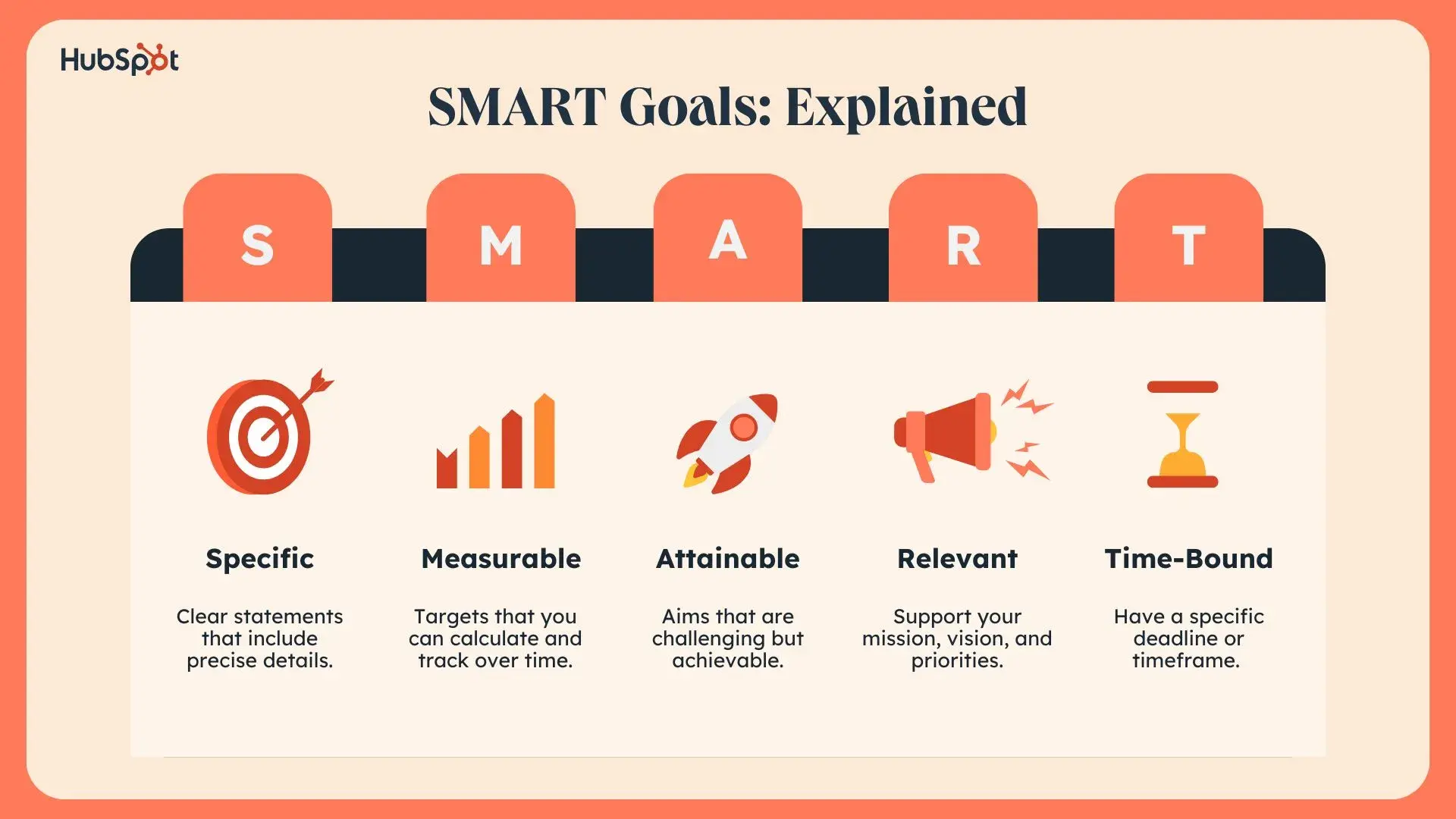
Step 3: Determine metrics for success.
Yes, every business is different. However, we can all agree that every business needs metrics and key performance indicators (KPIs) for success.
What metrics will you use to determine whether your business is successful? KPIs differ based on your medium, but standard metrics are gross profit margins, return on investment (ROI), daily web traffic users, conversion rate, and more.
Sales Rep KPIs vs. Sales Manager KPIs
For sales reps, KPIs zero in on metrics that shape their daily grind and productivity. Like these:
- Number of calls made: This one keeps reps on their toes, ensuring they’re hustling and maintaining a high level of outreach
- Conversion rate: Tracks how many prospects become customers, revealing the power of their pitches
- Average deal size: Monitors the average revenue per deal, pushing reps to close bigger, better sales
- Sales cycle length: Helps reps streamline their processes and identify ways to speed things up
For sales managers, KPIs take a broader, more strategic view of team performance. Key metrics include:
- Total revenue: Measures the team's overall revenue, monitoring progress towards sales targets
- Pipeline value: Shows the total value of deals in the pipeline, giving insight into future revenue
- Win rate: Indicates the percentage of deals closed successfully, highlighting strengths and areas for improvement in the sales process
- Employee retention rate: Keeps track of team stability and satisfaction — crucial for long-term success
- Training and development progress: Monitors the effectiveness of training programs, ensuring continuous skill development
How to Identify Sales Metrics
I kind of covered this step in the previous example, but it still warrants a bit more elaboration.
The “M” in SMART goals (“measurable”) is there for a reason. You can’t tell if your efforts were successful if you don’t know what “successful” actually means.
In my edtech sales example, I’m assuming ownership of an existing vertical and getting more out of it. So, it’s fair to assume that sales growth rate — the increase or decrease of sales revenue in a given period, typically expressed as a percentage — would be an effective way to gauge success.
I can also structure my goals and objectives around a sales growth rate of 20% Y/Y within my vertical. I’ll make sure my org is familiar with that figure and offer some context about what it would take to reach it — namely, how many institutions we would need to close and retain.
Step 4: Assess the current situation.
How is your business fairing right now? This information is relevant to determining how your current situation matches the goals and objectives you set during Step 2. What are your roadblocks? What are your strengths?
Create a list of the obstacles hindering your success. Identify the assets you can use as an advantage. These factors will guide you as you build your sales plan.
How to Evaluate Current Business Standing
Continuing the edtech example, I'll use the historical context I gathered and the objectives I set to frame how I look at my current circumstances.
For instance, consider my goal of increasing revenue by 20% Y/Y. In that case, I’d look at the company’s retention figures. Ideally, this would give me a sense of whether that needs to be a significant area of focus.
I‘d also try pinpointing trends in the colleges we’ve already closed. Are there any pain points we consistently sell on? I'll take a closer look at how we demo to see if we might be glossing over key elements of our value proposition. Maybe I can use conversation intelligence to get a better sense of how reps are handling their calls.
Ultimately, I would identify why we’re performing the way we are. These inefficiencies might result from our current strategy and how my team can best set ourselves up to sell as effectively as possible.
Step 5: Start sales forecasting.
Sales forecasting is an in-depth report that predicts what a salesperson, team, or company will sell weekly, monthly, quarterly, or annually. While it's finicky, it helps your company make better decisions when hiring, budgeting, prospecting, and setting goals.
After the COVID-19 pandemic, economics have become less predictable. StrActGro owner Claire Fenton states, “Many economic forecasters won't predict beyond three months at a time.” This makes sales forecasting difficult.
Luckily, there are tools at your disposal to create accurate sales forecasts.
For sales managers, I find HubSpot’s forecasting tool invaluable for tracking team progress toward goals. It forecasts revenue based on deal stages and their likelihood of closing. Plus, you can set up forecast categories to group deals and adjust them based on your team's insights.
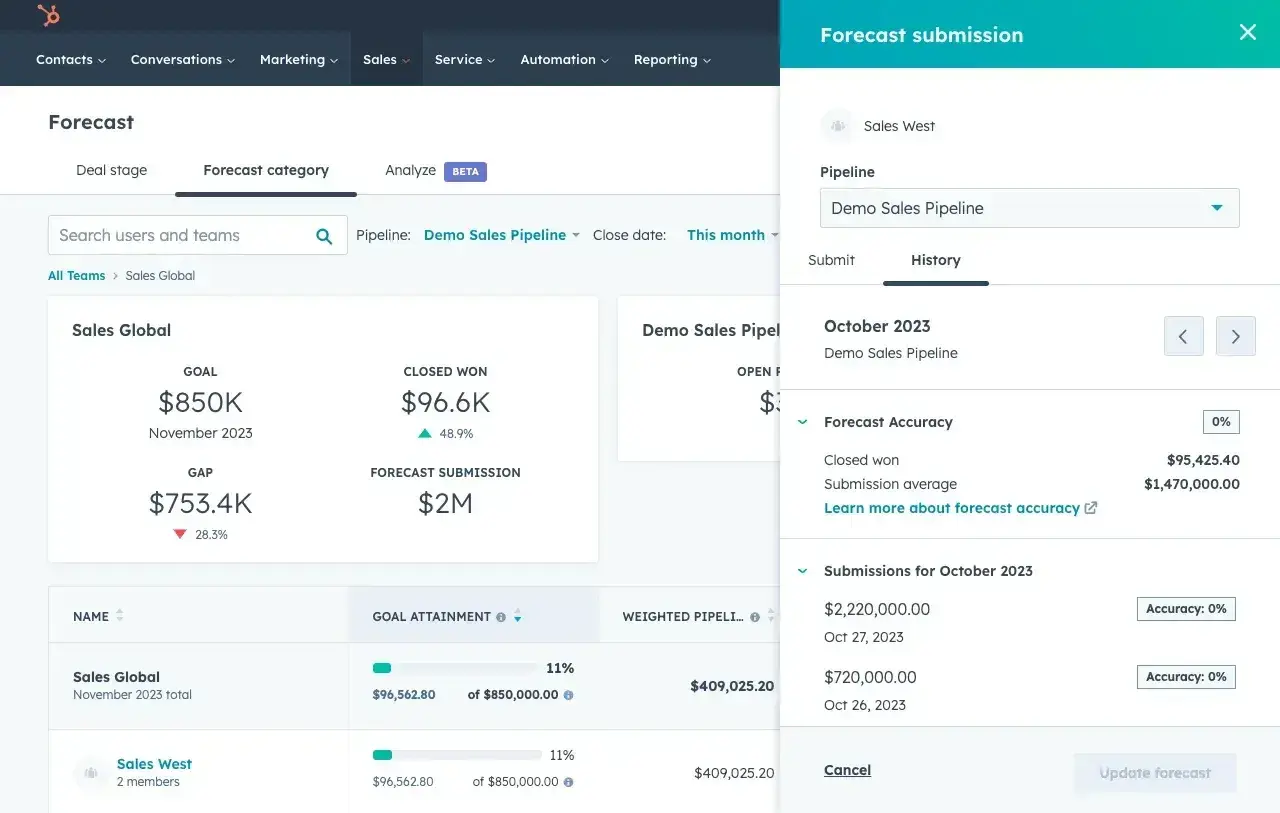
How to Forecast Sales
Following our edtech example, I’d approach this step by estimating how my sales org might perform in the allotted time window with the specific vertical we’re pursuing.
The method I choose will depend on several factors, including the number of concrete opportunities, available historical data, reps’ performance, and our insights about potential customers.
Let’s say I consider those factors and decide to run a multivariable analysis. Here’s how I’d go about it:
First, I’d take stock of the opportunities my reps have lined up. Then, I’d examine the reps working on those deals, their typical win rates, and their time to close. For example, if a rep works with a large institution and has a 50% chance of closing within the timeframe, I’d attribute 50% of the potential deal size to our forecast.
By repeating this process for all opportunities, I'll get a solid sense of the expected revenue within the allotted window.
Step 6: Identify gaps.
When identifying gaps in your business, consider your company's current and future needs. First, identify the skills your employees need to reach your goal. Second, evaluate the skills of your current employees.
Once you have this information, train employees or hire new ones to fill the gaps.
How to Identify Selling Gaps
In our edtech example, let’s say my forecast yielded results that didn’t align with what we needed to achieve our goals. To tackle this, I’d take a holistic look at our process, operations, and resources to find inefficiencies or areas for improvement.
Say I discover that our sales content and marketing collateral are outdated, with case studies missing our product’s newest and most relevant features. Meanwhile, our reps are booking demos, but the demos aren’t converting because of a lack of training and inconsistent messaging.
Finally, I notice that misalignment with marketing leads to prospects expecting unrealistic outcomes that our sales team can‘t deliver. Once I’ve identified those gaps, I’ll focus on ways to remedy those issues and improve those elements.
Step 7: Ideate new initiatives.
Many industry trends are cyclical. They phase in and out of “style.” As you build your sales plan, consider initiatives you might have overlooked.
Has your business relied solely on word-of-mouth and social media marketing? Now might be the time to try webinars or special promotions.
How to Ideate New Sales Initiatives
In our ongoing edtech example, I would ideate initiatives based on the gaps I identified in the previous step. This might involve updating our sales content and marketing materials to make them top-notch.
Next, I’ll introduce new training programs to help our team excel at conducting effective demos. Finally, I'll start working on a plan with marketing to ensure our messaging is aligned with theirs — so our prospects have realistic and clear expectations.
The key is to turn gaps into concrete, actionable plans. Just saying, “We’re going to be better at demos,” isn’t a plan — it’s a sentiment, and sentiments don’t translate into sales.
Step 8: Involve stakeholders.
Stakeholders are individuals, groups, or organizations with a vested interest in your company. They are typically investors, employees, or customers and often have deciding power in your business.
Towards the end of your sales planning process, involve stakeholders from departments that affect your outcomes, such as marketing and product. This will result in an efficient, more holistic, more actionable sales planning process.
How to Involve Stakeholders
Once I’ve pinpointed the key issues blocking my edtech startup’s sales team, it’s time to start recruiting the right people.
First, I’ll reach out to stakeholders handling our sales content and marketing collateral. They’re the ones who can create new, relevant case studies and whitepapers for the institutions we work with.
Next, I’ll go to middle management. Depending on the situation, I might offer more direction for coaching on demos. Or bring in a third-party training service for professional insights.
Finally, I’ll contact marketing leadership to clarify our message. Aligning the benefits and outcomes we highlight during pitches ensures that the schools we target have realistic expectations of our product.
Step 9: Outline action items.
Once you’ve implemented this strategy to create your sales planning process, the final step is outlining your action items.
Using your company's capacity and quota numbers, build a list of action steps that take you through the sales process. Think: writing a sales call script, identifying industry competitors, and strategizing new incentives or perks.
How to Create a Sales Action Plan
In our edtech example, some key action items might be:
- Revamp our prospecting strategy via more involved coaching and re-tooled sales messaging
- Revamp administrator and college dean buyer personas
- Conduct new training on demoing our software
- See our new prospecting strategy from ideation to execution
- Align with our sales enablement stakeholders for new, more relevant case studies and whitepapers
Obviously, this list isn’t exhaustive — but those are still the kinds of steps we would need to clarify and take to structure a more effective high-level strategy to produce different (ideally much better) results than we’ve been seeing.
One thing to keep in mind is that sales planning shouldn't end with creating the document.
I recommend repeating this process yearly to maintain your organization’s sales excellence. I would also advise you to set up a Standard Operating Procedure (SOP) around your entire sales planning process to spare yourself the headache of starting completely from scratch each year and ensure consistency across your organization. Check HubSpot’s free SOP template to see how you can get started.
Importance of the Sales Planning Process
Sales strategies based more on intuition than data might work sometimes, but they will always lack consistency and scalability. On the other hand, a clear sales planning process aligns the entire team toward common goals, ensuring effective and more cohesive collaboration.
I remember when my client’s sales numbers were consistently below target. Unsurprisingly, team morale was low.
After analyzing their processes, the sales manager realized the company lacked a coherent sales plan. So, they introduced a detailed sales planning process that included:

Free Sales Plan Template
Outline your company's sales strategy in one simple, coherent sales plan.
- Target Market
- Prospecting Strategy
- Budget
- Goals
Download Free
All fields are required.

- Setting realistic targets
- Identifying key prospects
- Implementing regular performance reviews
Within six months, the client saw a 27% increase in sales. Moreover, their team was more motivated and engaged than ever before.
This could happen for you (and your sales team), too. Take a moment to review the key benefits of having a sales planning process to drive growth and implement efficiency:
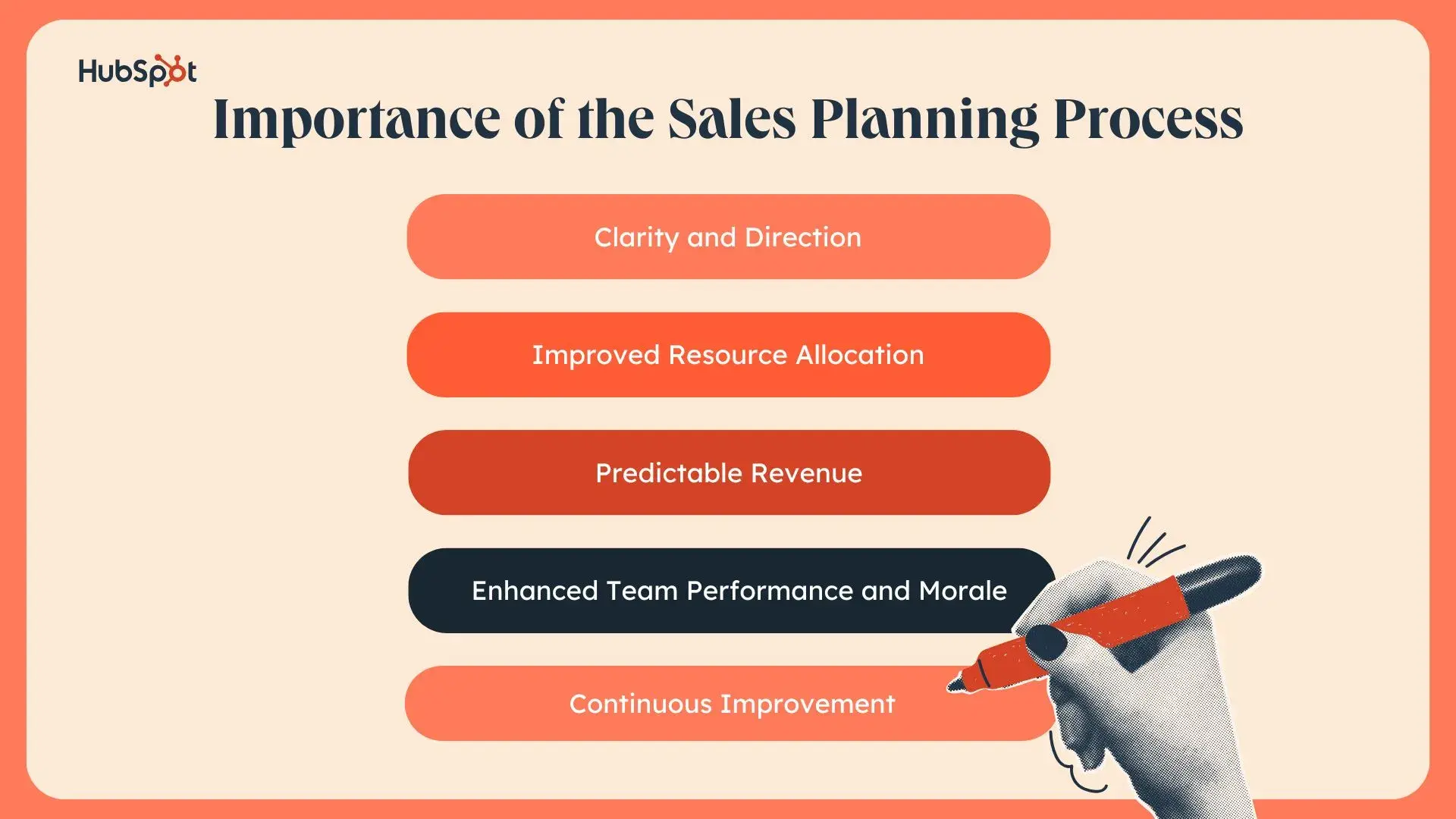
1. Clarity and Direction
In my experience, implementing a detailed sales plan changes everything. You‘ll have a clear path to follow, with defined goals and milestones that align everyone on your team. Without a clear plan, prioritizing leads is difficult, and you’ll often find yourself scrambling at the end of every month to meet targets.
2. Improved Resource Allocation
You can identify where to allocate your resources most effectively, whether it’s personnel, budget, or time. The same client I mentioned before used to spread their resources thinly across numerous prospects. Once they started planning, they knew better — they focused on high-potential leads, leading to better conversion rates and increased revenue.
3. Predictable Revenue
One of the most significant benefits of sales planning is predictability. With a predictable revenue stream, I can budget better and invest strategically in growth areas. In fact, according to a Logility report, companies that do effective sales planning see a 31% improvement in forecast accuracy.
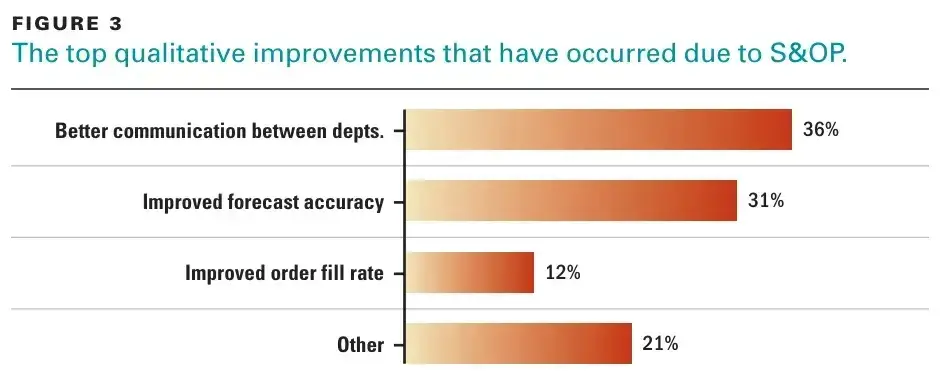
[alt text] a screenshot of a survey figure from a consumer goods study on sales operations and planning
4. Enhanced Team Performance and Morale
As I mentioned, my client’s sales team also struggled with low morale due to unclear targets and objectives. When they introduced a comprehensive sales plan to the equation, they could define clear goals and milestones.
This improved team morale and nurtured a sense of purpose and motivation, which boosted performance and job satisfaction.
5. Continuous Improvement
Sales planning establishes benchmarks and performance metrics are essential for accountability and continuous improvement within the team.
I always champion monthly review meetings where teams can regularly assess progress against the established plan. You can identify areas for improvement, recognize high performers, and address issues promptly.
Now that you’re committed to the sales planning process, I’ll show you how to approach into the written component of sales planning.

Ready to write your own plan? Download HubSpot’s Free Sales Plan Template.
What goes in a sales plan template?
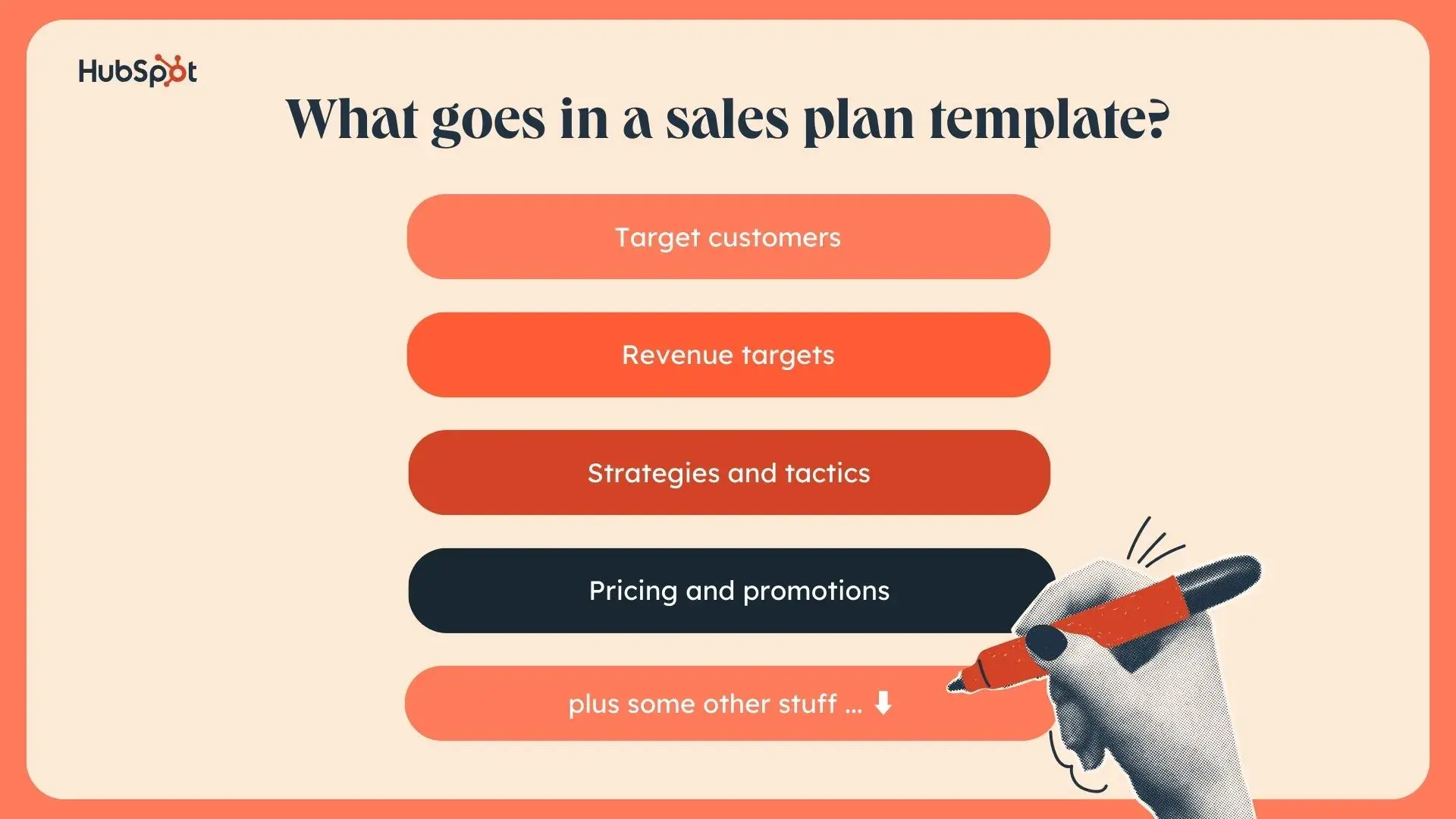
A typical sales plan includes the following sections:
- Target customers
- Revenue targets
- Strategies and tactics
- Pricing and promotions
- Deadlines and DRIs
- Team structure
- Resources
- Market conditions
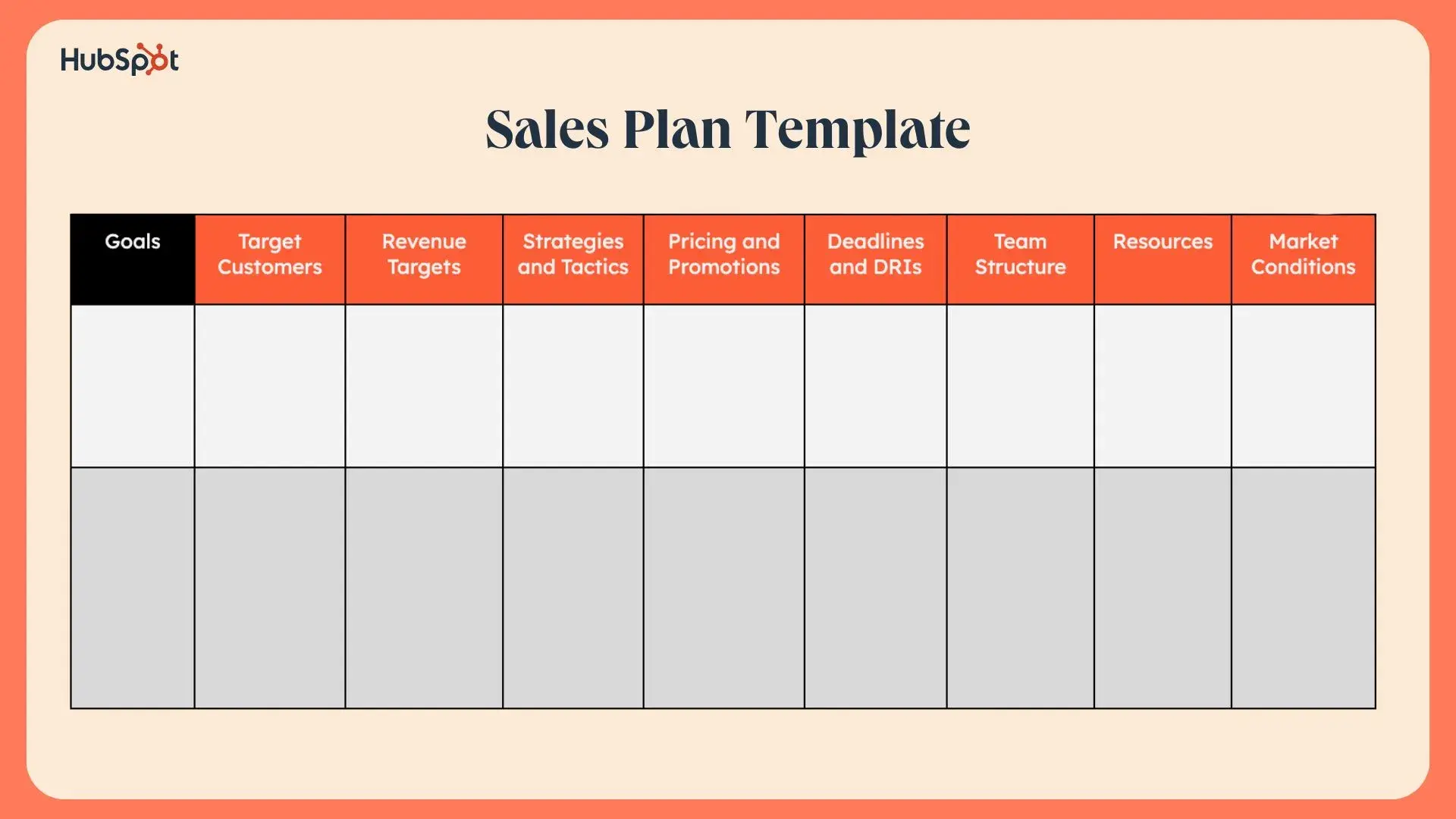
1. Target Customers
Your target customers are the people your company wants to serve with its products and services. They’re the ones most likely to buy from you. You identify them by breaking down your target market into smaller, more focused groups based on geography, behavior, demography, and more.
There are a few angles to approach this from; here’s how I recommend doing it:
- Segmenting customers by industry and business size. Not all companies have the exact needs. Identifying your ideal customer based on industry and company size allows you to tailor messaging effectively. For example, a SaaS company might target mid-sized e-commerce businesses needing cost-effective fulfillment and shipping optimization while offering an enterprise-tier solution for large retailers with more complex operations.
- Segmenting customers by pain points and buying motivations. Every customer has unique challenges that drive them to seek unique solutions. Understanding these pain points allows you to position your product as the best answer to their problem. For example, a logistics provider targeting e-commerce businesses should highlight solutions for reducing shipping delays and optimizing last-mile delivery, which are major pain points in the industry.
- Segmenting customers by geographical considerations. Different regions have different consumer behaviors, regulatory requirements, and logistical constraints. Your strategy should be customized for these variations. For example, a cybersecurity firm may target U.S. financial institutions with compliance-driven security solutions while offering more cost-effective, scalable options for emerging markets in international territories.
How to Identify Your Target Audience
Let’s continue with our edtech example for this section, too.
As mentioned, my territory is the East Coast, and my vertical is community colleges — so my target market is community colleges on the East Coast.
That’s clear, but my target customers aren’t just the institutions. I need to know the specific contact points when selling to these colleges.
Modern buying decisions often involve multiple stakeholders, especially in large organizations like community colleges. So, my understanding of target customers needs to be more detailed than just “representatives from the school.”
When selling curriculum scheduling software, I’d likely deal with administrators and deans — two personas with different responsibilities. I need to understand both types of customers for effective sales planning.
I’d also consider factors like their daily tasks, the pain points from those tasks, how my software could help, and why their lives would be easier with my product.
2. Revenue Targets
Target revenue is how much money your company aims to bring in during a given time. You can set them up a few different ways. Here are a few options for setting realistic revenue targets within your sales plan:

Free Sales Plan Template
Outline your company's sales strategy in one simple, coherent sales plan.
- Target Market
- Prospecting Strategy
- Budget
- Goals
Download Free
All fields are required.

- Set targets based on percentage growth from the previous year. One common approach is to set a revenue target by applying a percentage increase to last year’s revenue. If a marketing agency company earned $1 million in revenue last year and aims for 20% growth, its new target revenue would be $1.2 million.
- Set targets based on employee performance. Estimate revenue potential based on the number of employees and their output. If a business coaching business has 10 consultants, each generating $100,000 annually, the company can set a target revenue of $1 million, assuming full utilization of their capacity.
- Set targets based on industry trends. Consider external factors such as industry growth rates, economic conditions, and competitor benchmarks to define an achievable target. For example, if B2B software sales grow at 15% annually, your company might adjust its revenue target accordingly to stay competitive.
How to Set Revenue Targets
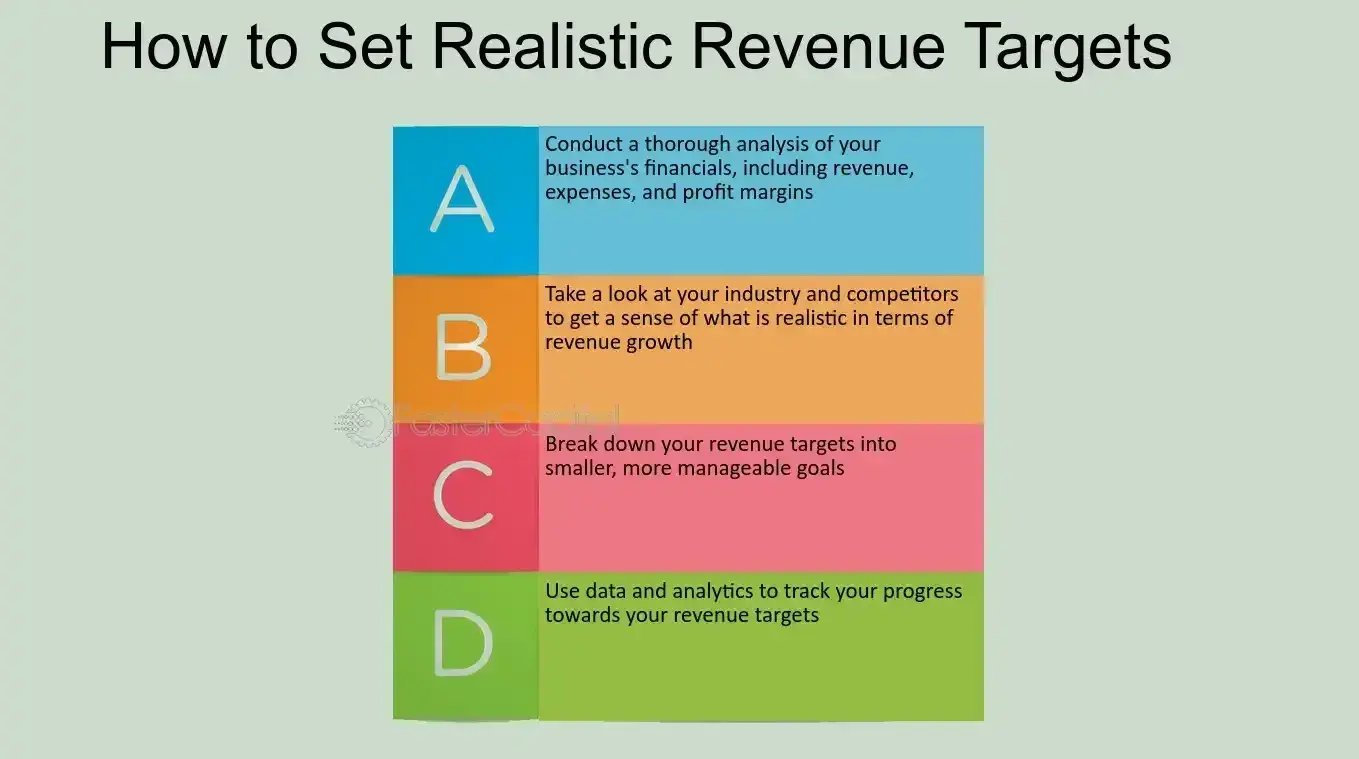
I would pull directly from the SMART goals defined earlier to set this up. I’ll look at the revenue figure we need to hit to achieve the 20% increase we aimed for earlier.
3. Strategies and Tactics
Strategies and tactics are the specific actions your team will take to reach those revenue targets. Here are a few extra tips to help your strategies and tactics go far:
- Leverage social media for lead generation. Social media platforms provide a powerful way to connect with potential customers, build brand awareness, and generate leads. For example, a tech startup company can use LinkedIn to share case studies and interact with prospects in industry groups to attract high-quality leads.
- Ask for referrals from existing clients. Referrals can be one of the most cost-effective ways to acquire new customers. Happy clients are often willing to introduce you to others in their network — especially if incentivized with discounts, exclusive offers, or loyalty perks. A structured referral program can make the process seamless and scalable. For example, a financial advisory firm offering a $100 credit for every successful client referral can encourage satisfied customers to spread the word, resulting in warm, high-converting leads.
- Maintain relationships with past clients. Just because a deal is closed doesn’t mean the relationship should end. Staying in touch with past clients can lead to repeat business, upselling opportunities, and valuable testimonials. For example, a real estate agent who follows up with past buyers annually — offering home maintenance tips or market updates — can increase repeat transactions and generate referrals.
- Implement a multi-touch follow-up strategy. Most sales don’t happen after just one touchpoint, so persistence is key. A structured follow-up process — including email sequences, phone calls, and retargeting ads — can keep leads engaged and nudge them toward conversion. For example, a retail brand using automated abandoned cart emails and personalized SMS follow-ups can recover lost sales and increase overall conversion rates.
Pro Tip: When it comes to making strategy decisions in sales, HubSpot’s 2024 Sales Strategy Report revealed that 66% of sales pros admitted that AI has helped them understand customers better and provide them with more tailored experiences. As you think about how to optimize this part of your sales process, consider employing AI to help you simplify the time-consuming stuff (i.e., generating copy, automating post-deal outreach, etc.)
How to Create Effective Sales Strategies
To create effective sales strategies, I’ll consider our organization’s goals and how responsibilities are allocated. We might leverage conversation intelligence to coach SDRs better and improve sales messaging.
We could also focus on enabling our account management team to retain existing customers. Lastly, I’ll revamp our demo process to highlight our most popular and impressive features.
4. Pricing and Promotions
Pricing and promotions typically attract customers’ attention. This section documents your offering’s price and any upcoming promotions to convert customers.
- Offer a free trial. A free trial allows potential customers to experience your product or service risk-free before purchasing. A great example of this is Apple TV’s 7-day free trial. Access to the streaming service is free for a week, then $10 afterward.
- Use limited-time discounts to create urgency. Time-sensitive promotions (like flash sales or seasonal discounts) create a sense of urgency and push hesitant buyers to purchase. Limited-time offers, whether a percentage off, a buy-one-get-one (BOGO) deal, or a bundle discount, work incredibly well to drive sales. Nike is one business that does limited-time discounts impressively well. Their Nike Member Days and seasonal sales (like Black Friday and back-to-school promotions) drive massive engagement by offering steep discounts on popular products for a short window of time.
- Leverage membership programs. Rewarding repeat customers with exclusive deals, points-based systems, or VIP pricing through a paid membership (monthly or yearly) encourages long-term engagement and brand loyalty. A great example of this is Savage X Fenty’s $60 “credits system” membership model. Instead of a traditional subscription, members are charged $60 each month, which they can then redeem as store credit toward new purchases.
A free trial is probably the most popular promotional tactic you’ll hear about. Amazon and Hulu also use it to reel customers in, hoping they’ll stick around after the trial ends.
That said, almost every company offers some kind of free trial (or creative spin on a typical discount offer) to attract new customers, so I’ll say this: Be strategic with what pricing and promotions you implement into your sales plan. Find the sweet spot between profitability and appeal to your target audience.
How to Set a Pricing Model
My sales team will thoroughly review our pricing model to ensure it aligns with our market position and revenue goals. I’d compare our prices with competitors to see if we’re too expensive or cheap.
The goal is to find a reasonable price for our target institutions without compromising our product’s perceived value. With a deep understanding of our market and a quality product, we aim to hit the right price point to meet our revenue targets.
5. Deadlines and DRIs
Deadlines and Directly Responsible Individuals (DRIs) outline any critical dates for deliverables and list who is accountable for their completion. A business has tons of moving parts. Creating a timeline and assigning responsibility to each task is necessary to keep your sales organization running successfully.
How to Establish DRIs
In our edtech example, some DRIs might include:
- Director of Sales Development. This person will ensure that our prospecting strategy is as productive as possible
- Account Executives. This person will demo the software and close deals with the institutions
- Account Managers. This person will be responsible for ensuring our existing accounts stay on board
6. Team Structure
Your team structure often depends on the size of your company. Smaller businesses tend to have a small team, which can exacerbate overlapping and confusion issues.
As your company grows, you’ll need more employees. The more employees you have, the harder it can be to manage these different members. Your sales plan needs to outline the members of your team and their specific roles to provide clarity.
7. Resources
Your team members are your most powerful asset for executing your sales plan, but they need the right resources to function and meet revenue targets. Check out my best picks for resources that could work for your sales team:
- Leverage CRM software for better customer relationships. A Customer Relationship Management (CRM) system helps sales teams track interactions, follow up on leads, and personalize outreach efforts. A real estate agency might use HubSpot’s Sales Hub to monitor client inquiries, set up automated email reminders, and analyze sales performance to improve conversion rates.
- Implement sales enablement platforms to equip teams with knowledge. Sales enablement tools provide reps with the necessary training materials, case studies, and sales scripts to do what they do best: Close deals effectively. A software company might use a sales enablement platform to centralize resources so their salesfolks can access up-to-date information and sales strategies anytime.
You can also use project management tools like Monday or Asana to keep track of deadlines. Design programs like Adobe Photoshop and Canva make creating compelling graphics for prospects easy. There’s no shortage of tools to utilize; you have to find the right ones that align with your team’s needs and workflow.
Pro Tip: According to HubSpot’s 2024 Sales Strategy Report, 79% of B2B sales professionals who use sales enablement content say it’s important when making a sale. Want to know another eye-opening stat? 58% of salespeople who utilize sales enablement content are more likely to outperform those who don’t. That said, here’s my opinion on equipping salesfolks with sales enablement resources: Go all out; make them a priority. Equipping your sales team with the right resources will guide them closer to stronger customer relationships and, inevitably, more successful deals.
8. Market Conditions
Market conditions cover crucial info about your industry and competitive landscape. What’s trending? Where are customers losing interest? Which competitors are gaining traction and why? Understanding the market helps shape your sales plan. Here’s how you can do it (without stressing out about information overload):
- Identify emerging trends to stay ahead. Keeping up with industry trends allows you to anticipate customer needs and adjust your offerings accordingly. Monitor shifts in consumer preferences, technological advancements, or regulatory changes that could impact your market. Using tools like Google Trends, industry reports (HubSpot’s ‘State of’ Reports are awesome), and other social media listening tools (Sprout Social is a great option) can help you stay updated.
- Analyze where customer interest is declining. Understanding why certain products, services, or strategies are losing traction can help you pivot before sales decline. Regularly analyzing customer feedback, review platforms, and website engagement metrics can highlight areas where interest is waning.
- Monitor competitor success and challenges. Watching which competitors are gaining traction — and why — can reveal strategic opportunities. Try using HubSpot’s Competitive Analysis Templates to assess how competitors are marketing, pricing, and engaging customers.
Next, I’ll dive into writing a sales plan. Have your pen and paper ready; follow with HubSpot’s free Sales Plan Template to make the most of this blog post.
How to Write a Sales Plan
- Create a mission statement.
- Define your team's roles and responsibilities.
- Identify your target market.
- Outline your tools, software, and resources.
- Analyze your position in your industry. Plan your marketing strategy.
- Develop your prospecting strategy.
- Create an action plan.
- List your goals.
- Set your budget.
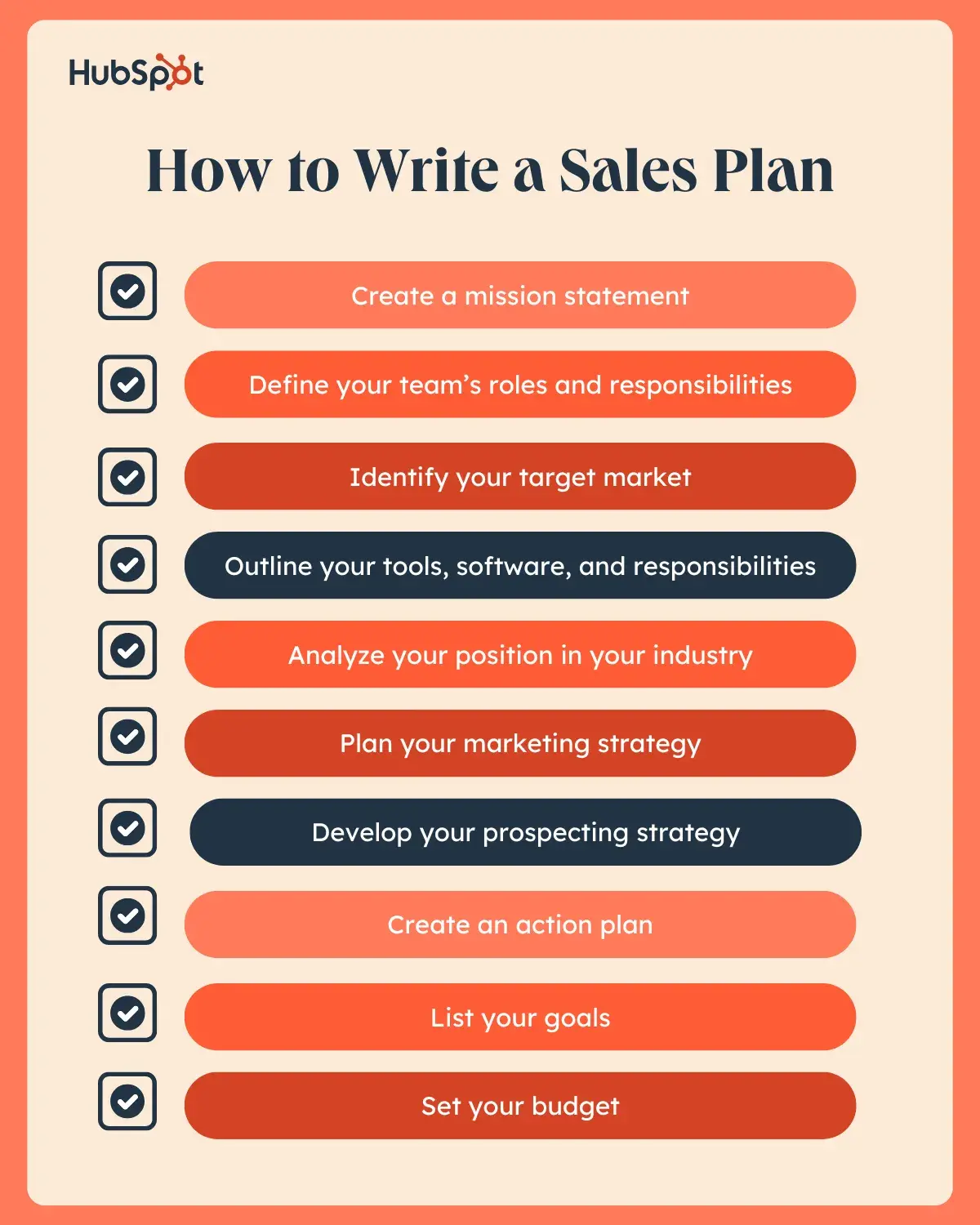
1. Create a mission statement.
Start your sales plan with a mission statement — a concise, straightforward distillation of what your business hopes to accomplish. Your mission statement sets the tone for your entire sales plan, so keep it aspirational yet realistic.
You don’t want to get too hung up on detailing the “how” behind your business here. Offer your vision — not your “About Us” page.
How to Create a Mission Statement
- Keep it concise: Aim for 1-2 sentences that define your overarching purpose.
- Focus on impact: Emphasize how your company benefits customers rather than just describing what you do.
- Avoid jargon: Use straightforward language that’s easy for both your employees and customers to understand.
Referencing our former edtech example, the company’s mission statement might say something like:
“Our mission is to empower higher education institutions to empower their students — maximizing schools' abilities to help their students realize their full potential by facilitating timely graduation and seamless class scheduling.”
2. Define your team’s roles and responsibilities.
Next, describe who’s on your team and their roles. You may manage five salespeople and work closely with a sales enablement professional and a sales ops specialist. If you plan to hire more, note their roles and when you’ll bring them on board.
How to Define Team Roles and Responsibilities
- Break down responsibilities clearly. For each role you create, specify what they do and own to avoid overlaps or gaps.
- Align roles with your sales goals. If you’re planning to expand into new markets, ensure you’ve got a dedicated team members for prospecting and closing deals.
- Plan for future hiring needs. If your company is anticipating scaling, indicate when and where additional hires will be needed.
Here’s a cursory overview of what a team structure might look like in the context of our edtech example:
- Joan (Director of Sales Development) will ensure that our prospecting strategy is as productive as possible
- Bobby and Sally (Account Executives) will be demoing the software and closing deals with the institutions
- Roger and Peggy (Account Managers) will be responsible for ensuring our existing accounts stay on board
- Don, Trudy, Bert, and Betty (Sales Development Representatives) will connect with institutions to book demos
3. Identify your target market.
Knowing your target demographic is non-negotiable (whether you’re writing your first-ever sales plan or your 15th). To help you get a clear picture of what this process looks like, ask yourself questions like this:
- What do your best customers look like? Do they all belong to a specific industry?
- What common pain points or challenges do they face that your product or service solves?
- How do they typically make purchasing decisions? Are multiple stakeholders involved?
Different products mean different buyer personas. For example, HubSpot’s salespeople might sell marketing software to CMOs and sales software to sales directors.
Keep in mind that this section of your sales plan can change dramatically as your solution and strategy evolve and you adjust product-market fit. In the beginning, when your product was in its infancy, and your prices were low, you may have found success selling to startups.
Once the product is more robust and you’ve raised the price, mid-market companies are likely a better fit. That’s why I can’t stress this enough: It’s really essential to review and update your personas consistently.
How to Determine Your Target Market
- Segment your audience. You can do this based on industry, company size, or specific pain points.
- Create buyer personas. Buyer personas help you understand the types of decision-makers and customers that’ll interact with your product or service.
- Re-evaluate regularly. Markets change, needs change … Your ideal customer today may not be the same as a year from now.
Again, I covered this one in the previous section, but for the sake of you not having to scroll back up, I’ll say it again: In our edtech example, my target market is community colleges on the East Coast. But it‘s not just about the institutions. I need to know the points of contact I’ll be dealing with at these colleges.
Modern buying decisions involve multiple stakeholders, especially in large organizations like community colleges. I’ll likely interact with administrators and deans when selling curriculum scheduling software, each with unique responsibilities. I need to understand both personas well when planning sales.
4. Outline your tools, software, and resources.
Include a description of your resources, not just software. Detail key tools like your CRM and sales tools. Additionally, don’t ignore other elements like budgets for contests, training materials, and sales collateral.
How to Outline Your Tech Stack
In our edtech example, I might find we’re using:

Free Sales Plan Template
Outline your company's sales strategy in one simple, coherent sales plan.
- Target Market
- Prospecting Strategy
- Budget
- Goals
Download Free
All fields are required.

- A CRM to provide a centralized repository of our prospect and customer data
- Sales tools to streamline lead generation and prospecting through features like email automation and tracking, lead scoring, pipeline management, and more
- Conversation intelligence software will guide better-structured, more effective coaching for our sales calls
- Sales enablement software to centralize and manage our sales enablement resources
- An additional budget could be allocated for a SPIFF to motivate SDRs to book more demos
- Case studies show how other community colleges have successfully leveraged our software
- Any other resources we might have available that can be used to educate buyers or enhance our sales professionals’ efforts
5. Analyze your position in your industry.
Now, name your competitors. Compare your products to theirs, highlighting their strengths and weaknesses. Discuss their pricing versus yours. Keep an eye on market trends, too.
If you’re working in SaaS world, note which vertical-specific software is gaining traction. If you sell ads, you should mention the rise in programmatic mobile advertising and try to predict how these changes will influence your business. It’s all about staying ahead of the curve and adapting proactively.
How to Evaluate Industry Positioning
- Research competitors’ pricing, features, and sales strategies
- Gather customer feedback to understand why they choose your product over others
- Monitor industry trends to anticipate shifts in customer demand
In my edtech company, I’d look closely at the types of institutions that buy from us. What are their enrollment figures? If we had tiered pricing, which price points would they be choosing? What are their typical budgets? Most importantly, what pain points drive them to seek our solution?
Next, I’d examine our competitive landscape — ideally, gathering the same information for our competitors and their customers. By pinning down these elements, I’d know what kind of buyers gravitate to each solution in our market. This will show how prospects perceive our offering and where we stand in the competitive landscape.
This insight helps my team understand their selling position, identify which institutions will be most receptive to our efforts, and determine the best approach for each engagement.
Pro Tip: I recommend using AI tech wherever possible in this section of your sales plan. Why? Because AI is best used for research (if nothing else). I say this because, as a sales pro, you should always be focused on boosting buyer confidence and intently listening to a prospect’s needs and challenges with your product or service.
By utilizing AI technology first, you’re able to cut down the time spent doing the things I listed above and, in turn, create more time for doing meaningful work later.
6. Plan your marketing strategy.
Next, describe your pricing and any promotions you’re planning on running. What key actions will you take to increase brand awareness and generate leads? Note the impact on sales.
Here’s a mock version:
- Product A: Free upgrade if you refer another customer from January 1-20 (20% increase in monthly sales)
- Product B: Increasing price from $40 to $45 on February 2 (2% reduction in monthly sales)
- Product C: Decreasing price from $430 to $400 on March 1 (15% increase in monthly sales)
- Product D: No change
How to Approach Marketing Planning
- Content Marketing: Blog posts, thought leadership articles, newsletters, case studies
- Referral Programs: Encourage existing customers to refer others
- Pricing Promotions: Temporary discounts, free trials, or bundled offers
For our edtech company, let’s say we intend to lean heavily on an inbound marketing strategy.
In that case, company leadership would want to invest in a company blog that covers trends and concepts in the education industry. Ideally, that resource will produce a steady stream of leads while simultaneously establishing our business as a trusted authority in the space.
7. Develop your prospecting strategy.
A structured prospecting strategy ensures a steady flow of high-quality leads into your sales pipeline. Ask yourself: How will my sales team receive and qualify the leads generated by your marketing strategy? Once you’ve got your answer, be sure to include the criteria prospects should meet before sales reps contact them.
How to Create an Effective Sales Prospecting Strategy
- Define lead qualification criteria (e.g., company size, budget, need for your product)
- Use a mix of outreach methods (email, phone calls, LinkedIn messaging)
- Automate lead nurturing with email sequences and follow-ups
Imagine how our hypothetical edtech company’s inbound marketing infrastructure development pans out. We’re able to maintain a reputable blog about the education industry that brings in a steady stream of leads, which could provide the basis for an effective prospecting strategy.
Our content marketing department can produce and qualify warm leads to pass to our sales team. Ideally, we’ll have more effective, focused criteria for determining whether and how to contact those leads.
From there, we can focus primarily on email outreach — a plan that a more conventional cold-calling strategy could complement.
8. Create an action plan.
This section summarizes your game plan for hitting your revenue targets.
Once you’ve outlined your goals, you’ve got to figure out how you’ll achieve them. Try to be thorough but concise when detailing these steps, and support any items you detail with a clear, viable timeline.
How I Create a Sales Action Plan
- I define clear objectives
- I set deadlines for key initiatives
- I assign ownership to team members for each task
Here’s what part of the action plan might look at our hypothetical edtech company:
Objective: Increase revenue in our East Coast community college vertical by 20% Y/Y.
- Revamp our prospecting strategy via more involved coaching and re-tooled sales messaging (Timeline: Q1)
- Leverage conversation intelligence to shadow calls — offering more perspective on practical elements of current strategies and areas for improvement
- Revamp administrator and college dean buyer personas (Timeline: Q1)
- Reference historical data in CRM for trends in successful and unsuccessful sales engagements with these kinds of contacts
- Implement a new training framework for demos (Timeline: Q1)
- Conduct email outreach to inbound leads (Timeline: Q1-Q4)
I can flesh this plan out to cover the key actions that will shape our high-level strategy and guide the more granular aspects of its implementation. Committing to writing plans is crucial in sales, including action items in your sales plan.
9. List your goals.
Most sales goals are revenue-based. For instance, you might aim for $10 million in annual recurring revenue (ARR). Alternatively, you can set a volume goal, like acquiring 100 new customers or closing 450 sales.
Regardless of your approach, make sure your objective is realistic. Otherwise, your entire sales plan won't hold much value.
Consider your product’s price, total addressable market (TAM), market penetration, and available resources (including your sales team and marketing support). Your goal should align closely with your broader business objectives.
How to Define Your Goals
- Revenue-based goals
- Volume-based goals
- Customer-based goals
- Region-specific goals
For example, if our edtech company aims to move upmarket, we might aim to “Acquire 20 Enterprise logos” rather than just “Sell X in new business.” This approach encourages targeting the right customers rather than just chasing numbers.
You’ll likely have multiple goals. Identify the most important, then rank the rest by priority. If you have territories, assign specific sub-goals to each. That will make it easier to identify over- and under-performers.
Don’t forget to lay out your timeline. Regular benchmarks indicate if you’re on track, ahead, or falling behind. Say your first-quarter sales goal is $30,000, and you know from last year’s performance that January and February are slower months. Your timeline might look like this:
- January: $8,000
- February: $8,000
- March: $14,000
Include DRIs if applicable. For instance, Rep Carol might have a January quota of $5,000, while Rep Shane — who’s still ramping up — might have a $3,000 quota. This approach helps smaller teams avoid duplicating efforts and prevents blame-shifting if targets aren’t met.
10. Set your budget.
Describe the costs associated with hitting your sales goals. That usually includes:
- Pay (salary and commission)
- Sales training
- Sales tools and resources
- Contest prizes
- Team bonding activities
- Travel costs
- Food
Compare the sales plan budget to your sales forecast for accurate budgeting.
If you want to improve your plan, read on for tips on creating a highly effective sales plan.
Tips for Creating an Effective Sales Plan
I’ve reviewed what you should include in a sales plan, including some examples and mockups.
Now, I’ll share some tips and tricks for creating a sales plan that helps you hit target numbers and exceed your higher-ups’ expectations.
- Use industry trends to strengthen your plan. When presenting your sales plan to a stakeholder, use industry trends to highlight why your plan will be effective.
- Specify the technology you’ll use to track success. You can do this for internal reference or let stakeholders know how you'll measure success. Some tools you can consider include CRM and dashboard software.
- Support your budget proposal with hard facts and data. If you’re creating a budget as a part of your plan, support it with previous performance data and sales forecasts.
- Create different plans for each team. If you create a sales plan for business development, inbound sales, outbound sales, field sales, and so forth, you can get even more granular and specific in your goals and KPIs.
- Get marketing’s input. Marketing and sales alignment is critical for the success of your sales plan. The more input you have from marketing, the more you can align your lead generation, prospecting, and nurturing efforts.
- Talk with your sales reps to understand their challenges. It might be easy to get lost in numbers and forecasts, but it’s essential to know your sales representatives’ day-to-day to understand what will and will not prove practical or feasible.
- Complete an in-depth competitive analysis. You must know what the competition is doing well to create a plan that nudges your company in that direction.
Types of Sales Plans
You can create a few different types of sales plans for your organization. I’ve gathered some examples so you can find the right fit for your needs. Check them out below:
1. 30-60-90-Day Sales Plan

Download Now: Free Sales Training Template
This general sales plan is defined not by theme but by time frame. You’ll create three goals: one for the 30-day mark, another for the 60-day mark, and the last for the 90-day mark. You can focus on quotas or reducing customer churn by a certain percentage.

Consider this plan if you're new to the role since you can use it to track your progress during your first 90 days. A 30-60-90 day plan can also be useful for a new business that's still figuring out its sales goals.
Peggy Ratcliff McKee, an executive career coach at Career Confidential, describes the 90-day plan as “a great starting point… [where] you may end up speeding up your goals or extending them depending on the specific needs of your new company.”
2. Marketing-Alignment Sales Plan
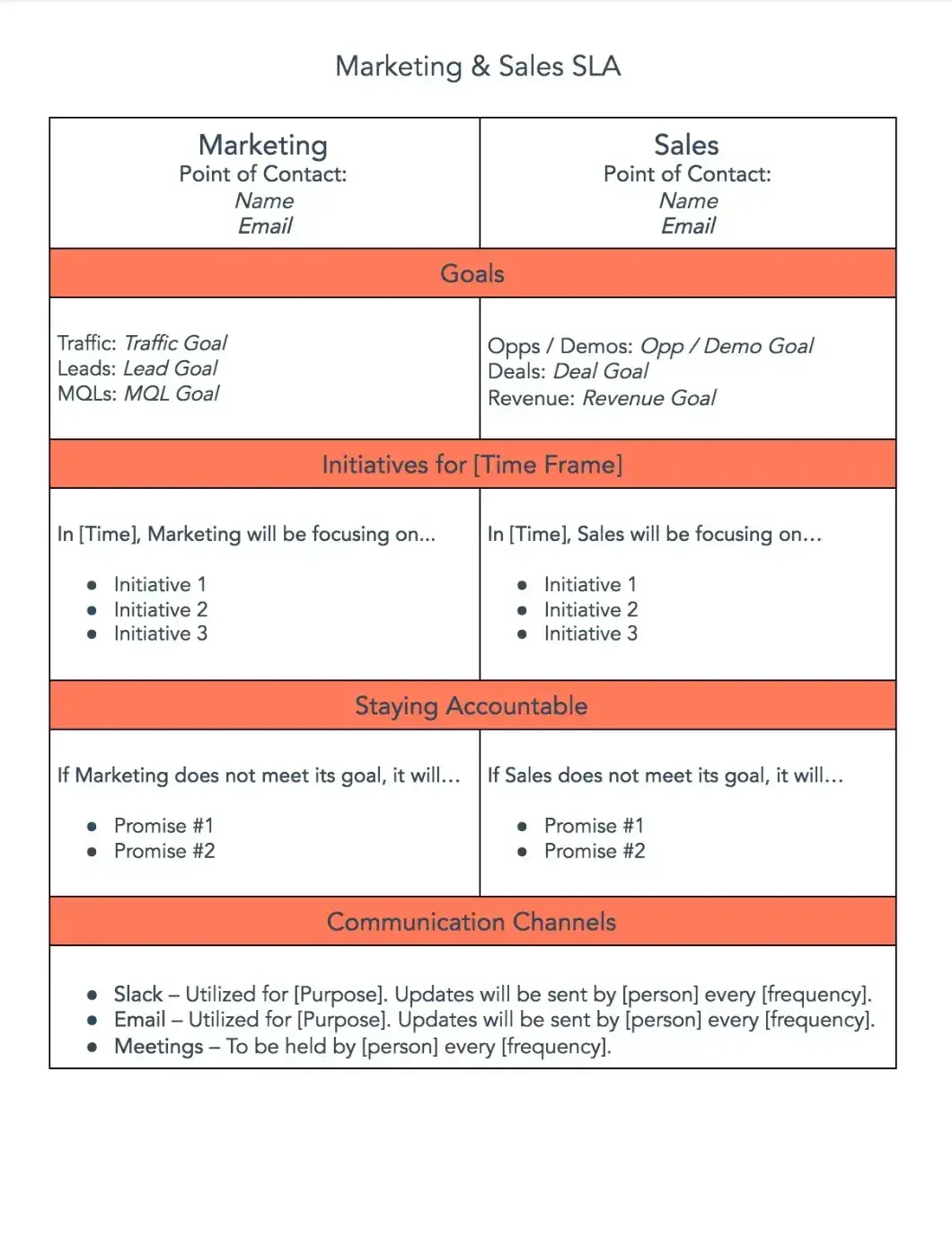
Download Now: Free Marketing & Sales Alignment Template
In many ways, a traditional sales plan is already aligned with marketing. Still, you can create a marketing-alignment sales plan if your organization has not yet aligned both departments.
The plan will focus on establishing ideal customer profiles and buyer personas and aligning marketing’s messaging with sales’ product pitch. A strong marketing-sales alignment ensures everyone within your organization is on the same page and reduces miscommunication.
3. Business Development Strategic Sales Plan

Download Now: Free Strategic Business Planning Template
A strategic sales plan for business development will focus on attracting new business to your company by networking with other companies, sponsoring events, and doing outreach. In your sales plan, you'll want to choose the right KPIs that best reflect performance for these specific outreach channels.
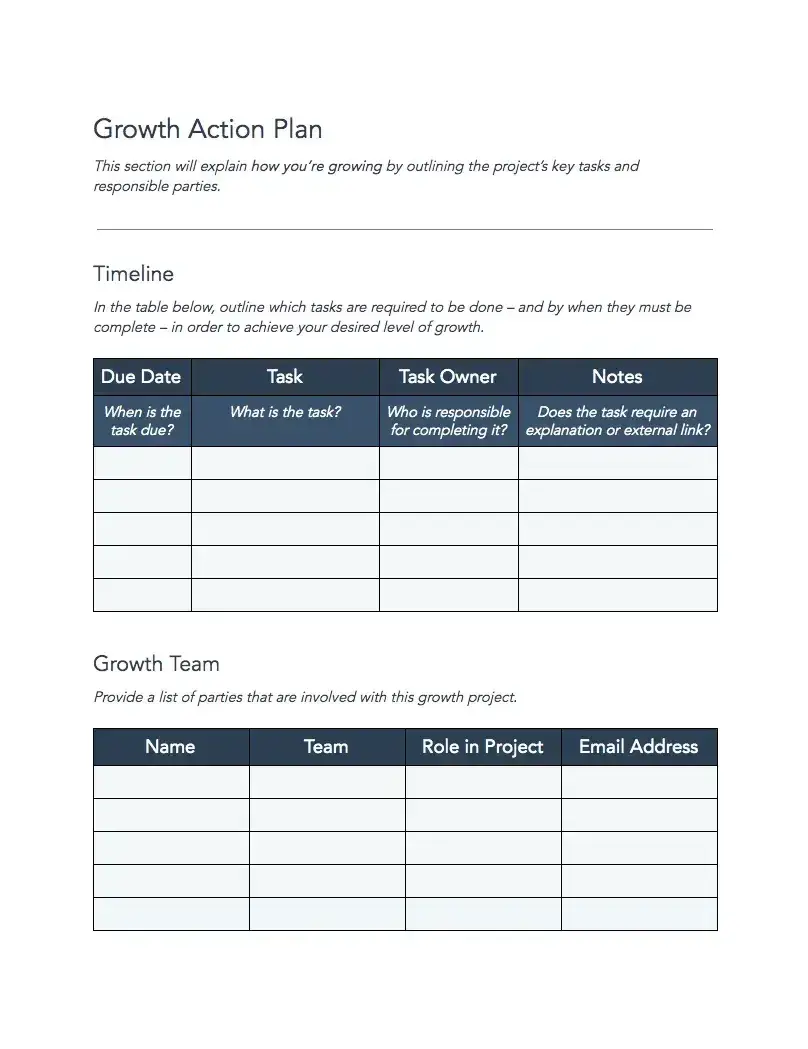
Business development is imperative for long-term success because it will help your organization better understand your industry's competitive landscape and strategize how to stand out. It also ensures everyone at your company works toward a common goal.
4. Market Expansion Plan

Download Now: Free Marketing Plan Template
A market expansion plan outlines a task list and target metrics when expanding into a new market or territory. This sales plan explicitly addresses a target market in a new geographical area.

You’ll typically consider distribution costs and, if applicable, time zone differences between your sales representatives and target buyers, as well as other logistical factors.
5. New Product Sales Plan
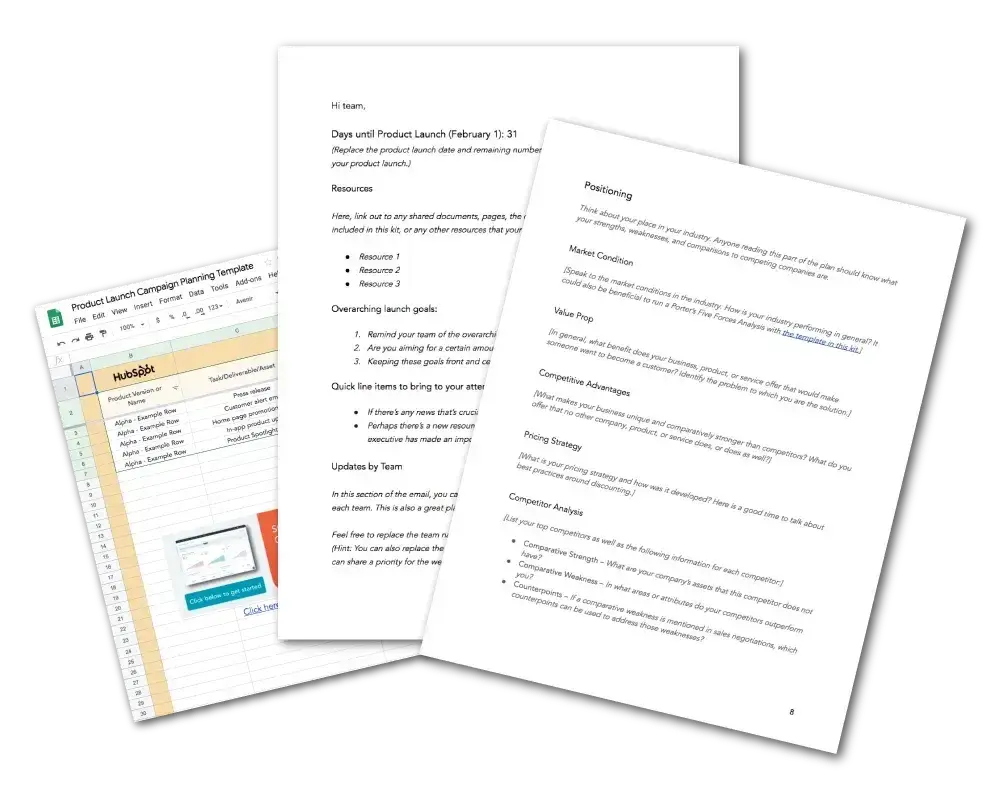
Download Now: Free Product Launch Kit
If you’re launching a new product, create a sales plan specifically to generate revenue from the new launch.
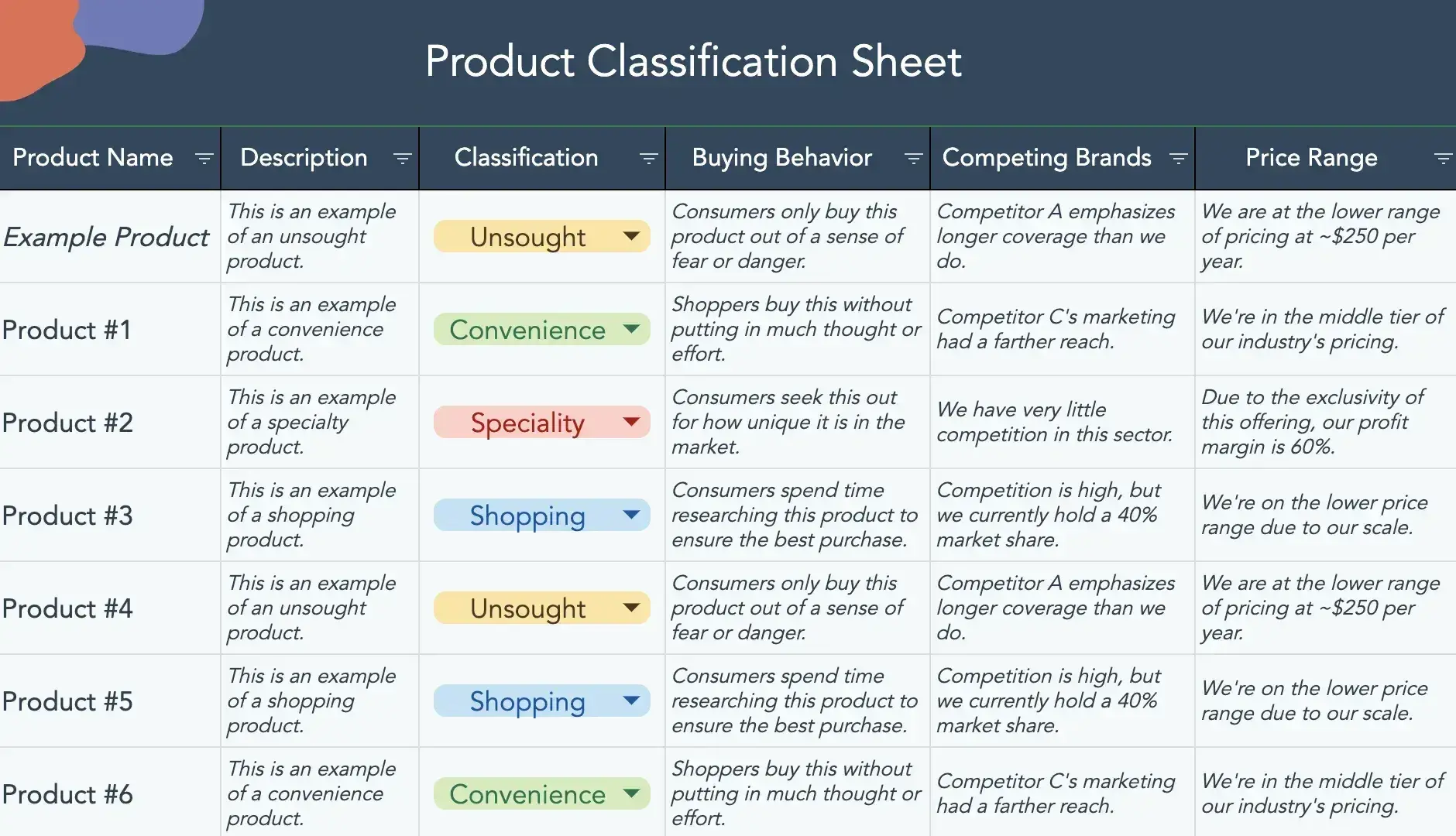
In my experience, conducting competitive analysis, determining a sales strategy, strengthening brand positioning, and securing channel partners is crucial if you're shifting to a channel sales model.
Strategic Sales Plan Examples
If you need some more inspiration, check out these examples of sales plans below:
1. Sales Plan Template by HubSpot

We’ve created a sales plan template outlining a sales plan’s key elements. This template will walk you through each of the steps to write a sales plan of your own.
Our plan allows you to easily communicate to your organization your goals, how you'll accomplish them, and what support you need.
2. Sample Sales Plan by BestTemplates

Organizing your strategies and goals with a sales plan will help you and your sales team stick to the targets you've set. This nine-page template provides plenty of opportunities to create a concrete action plan.
I like it because it includes a goals section before breaking it down into specific areas such as demand generation, implementation, measurement, and evaluation.
3. 1-Page Sales Plan by BestTemplates
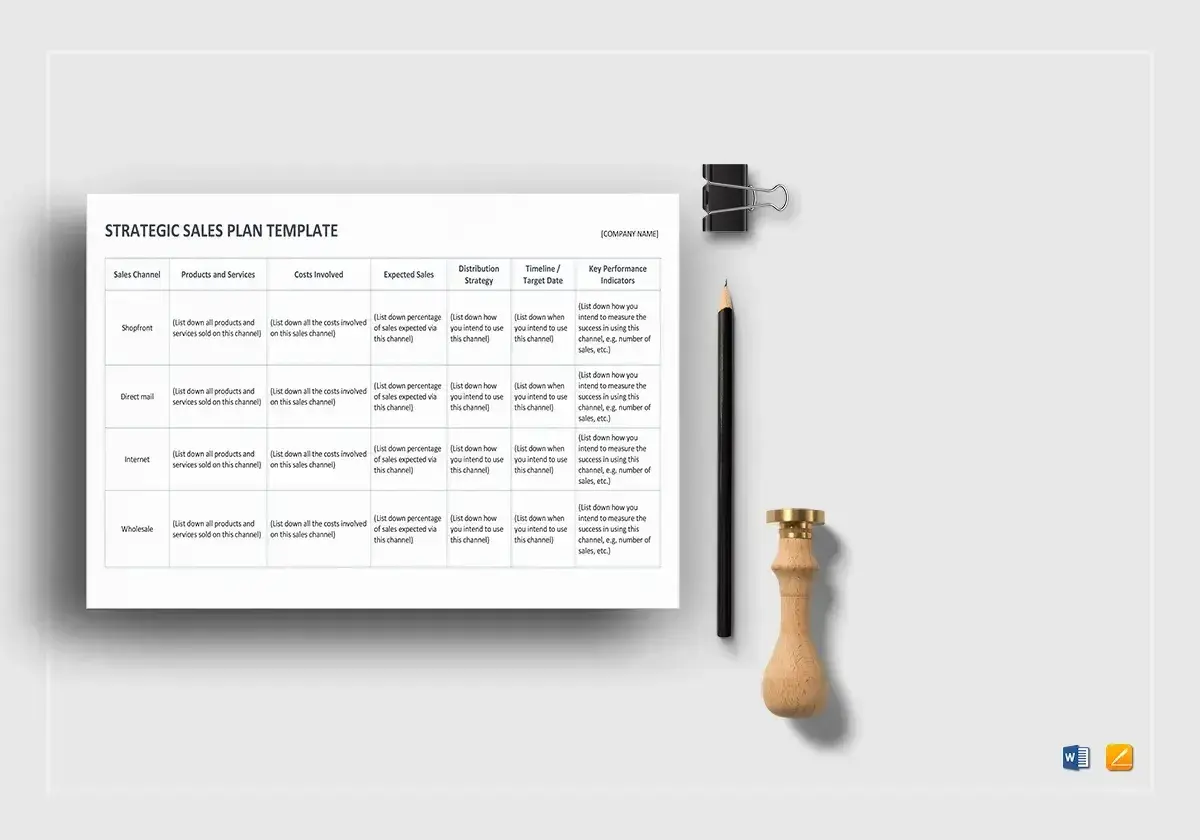
A sales plan doesn’t need to be hundreds of pages long. Try consolidating your sales plan into a page or two. This template is an excellent example of keeping it short and sweet while still communicating the most important elements of the plan.
In landscape mode, this strategic sales plan includes a channel, expected costs and sales, distribution strategy, and KPIs in an easy-to-read grid layout.
4. Strategic Distribution Sales Action Plan Template by Venngage
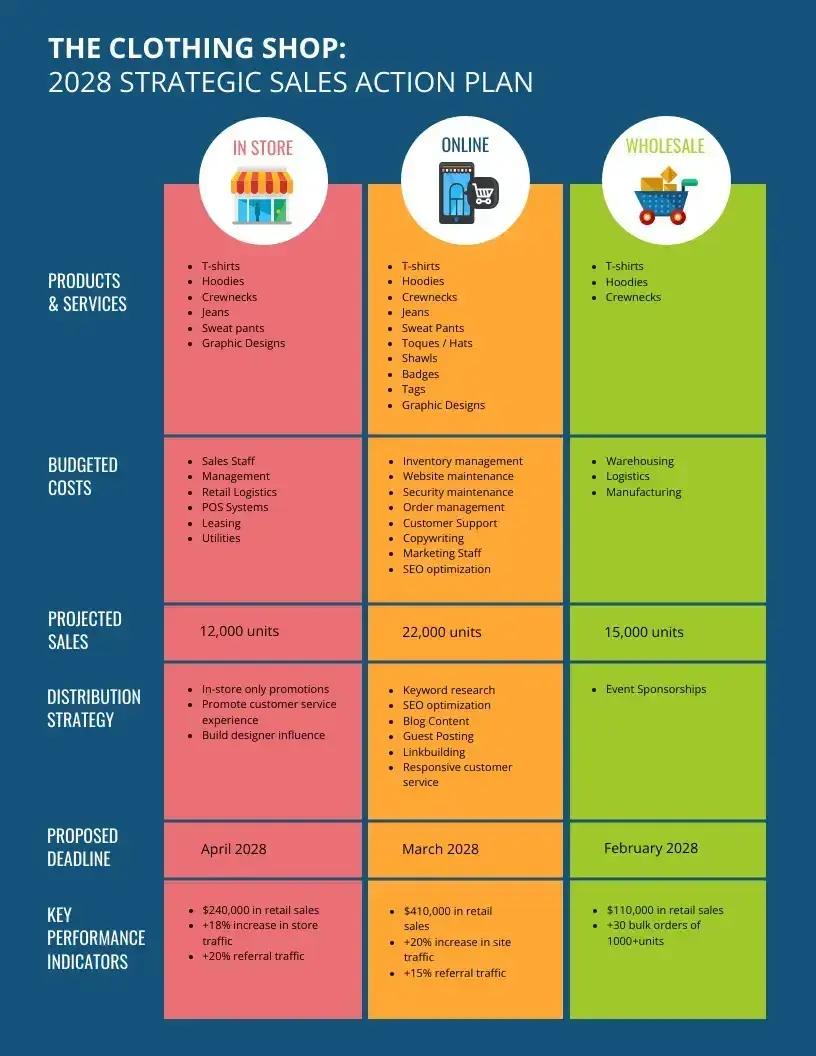
Choose a design that fits your needs and create your sales plan using Venngage’s interface, which includes custom charts, stock photos, and illustrations. You'll have several visually interesting options available in just a single tool.
I like this plan because it’s organized by type of sale: in-store, online, and wholesale. This makes it easier to identify each sales channel's needs and which departments contribute to their success.
5. Small Business Sales Plan by FitSmallBusiness
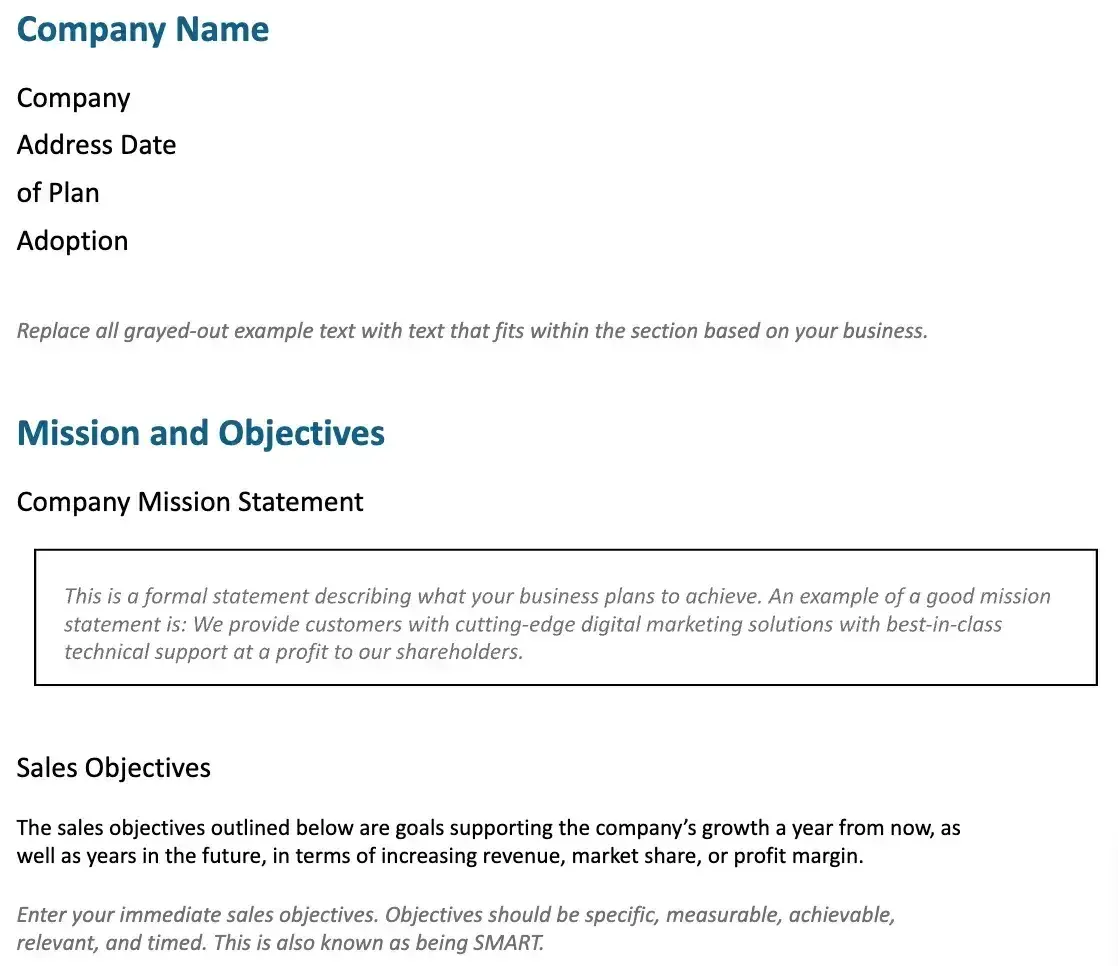
You may not have a fully stacked sales team if you run a small business; that’s totally okay. You and your employees likely wear many hats, so it’s important to establish a strong sales strategy for your company that future hires can build off of.
Sometimes, simpler is better. This plan relies on several standard sections to draw up your plan, with boxes that can be quickly filled out using Microsoft Word or Google Docs.
6. Sales Strategy Diagram from Creately
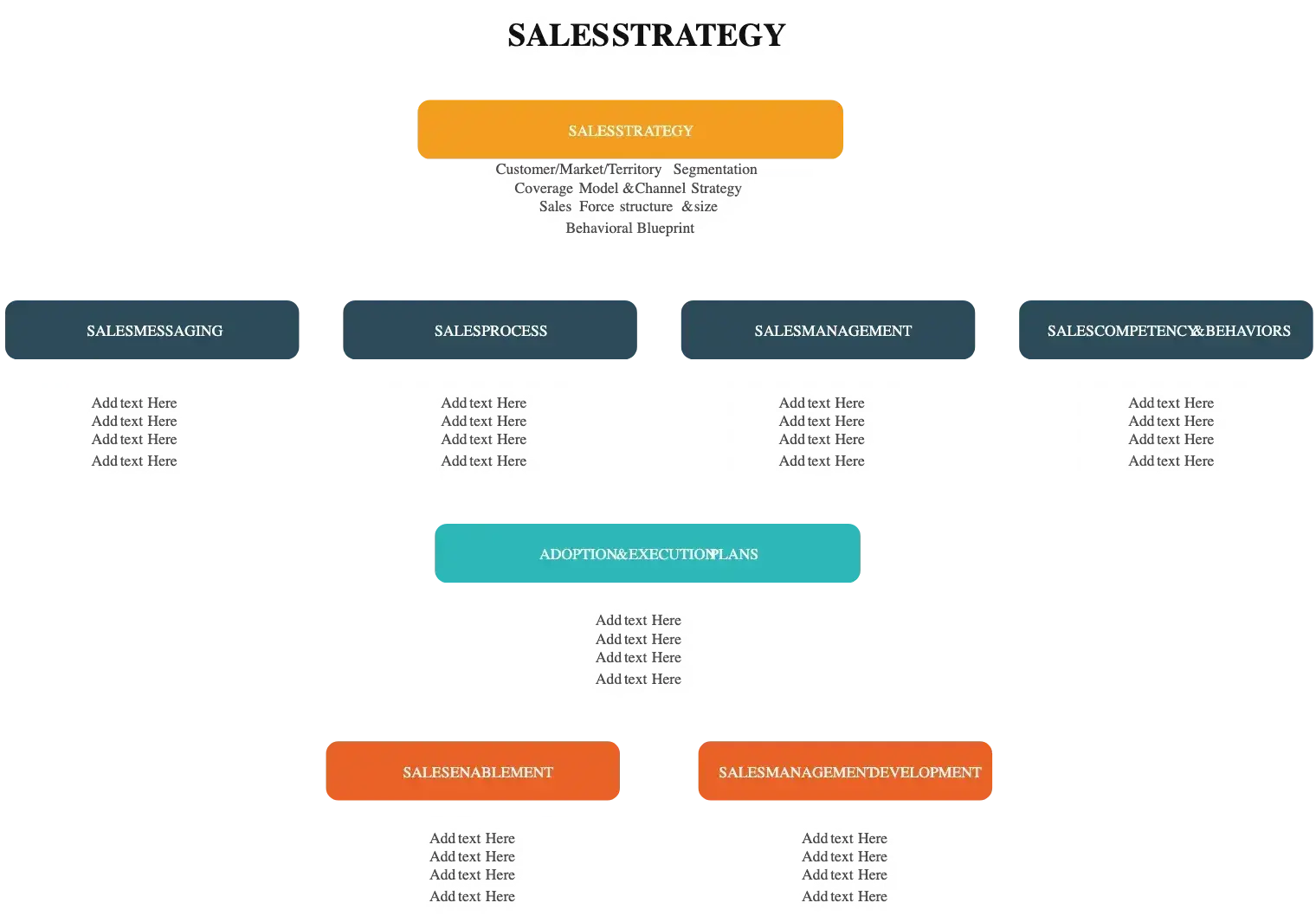
If you’re more of a visual person, creating a diagram for your sales strategy will be immensely helpful. Use Creately to create an attractive sales strategy to share with your team.
I like this template because it allows you to map out the key elements of your strategy by categorizing action items and values.
7. Sales Action Plan by BestTemplates

A sales action plan lets you dive into the details of your sales strategy. This one has a minimalistic (but super easy-to-follow) layout.
This sales action plan is effective because it focuses on the more concrete elements of achieving your sales goals, such as positioning and strategic plays. It’s eight pages long and fully customizable in either Word or Pages.
8. 30-60-90 Day Sales Plan by Template.Net
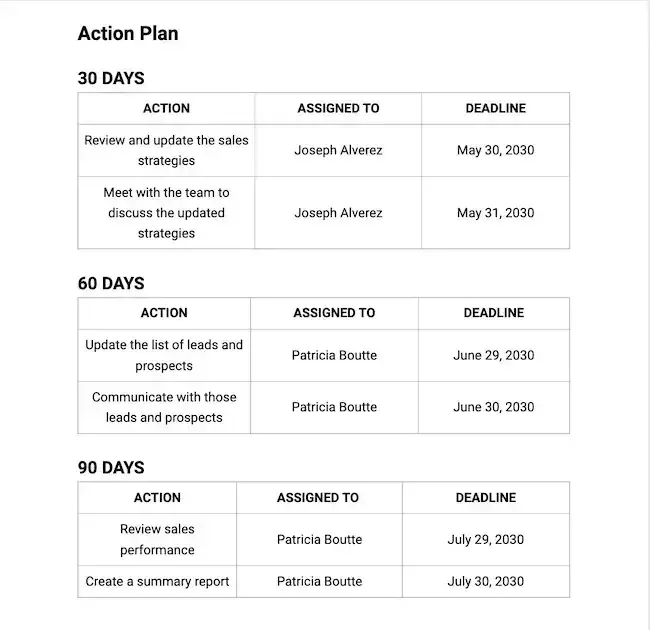
I love 30-60-90 day plans because they allow you to set a realistic pace for accomplishing your goals, whether they are short- or long-term.
This sales plan does some of the hard work for you by outlining tasks related to your sales goals. You can check off boxes as you complete each item to ensure you're creating a sound sales strategy.
9. Microsoft Word Sales Plan Template from TemplateLab
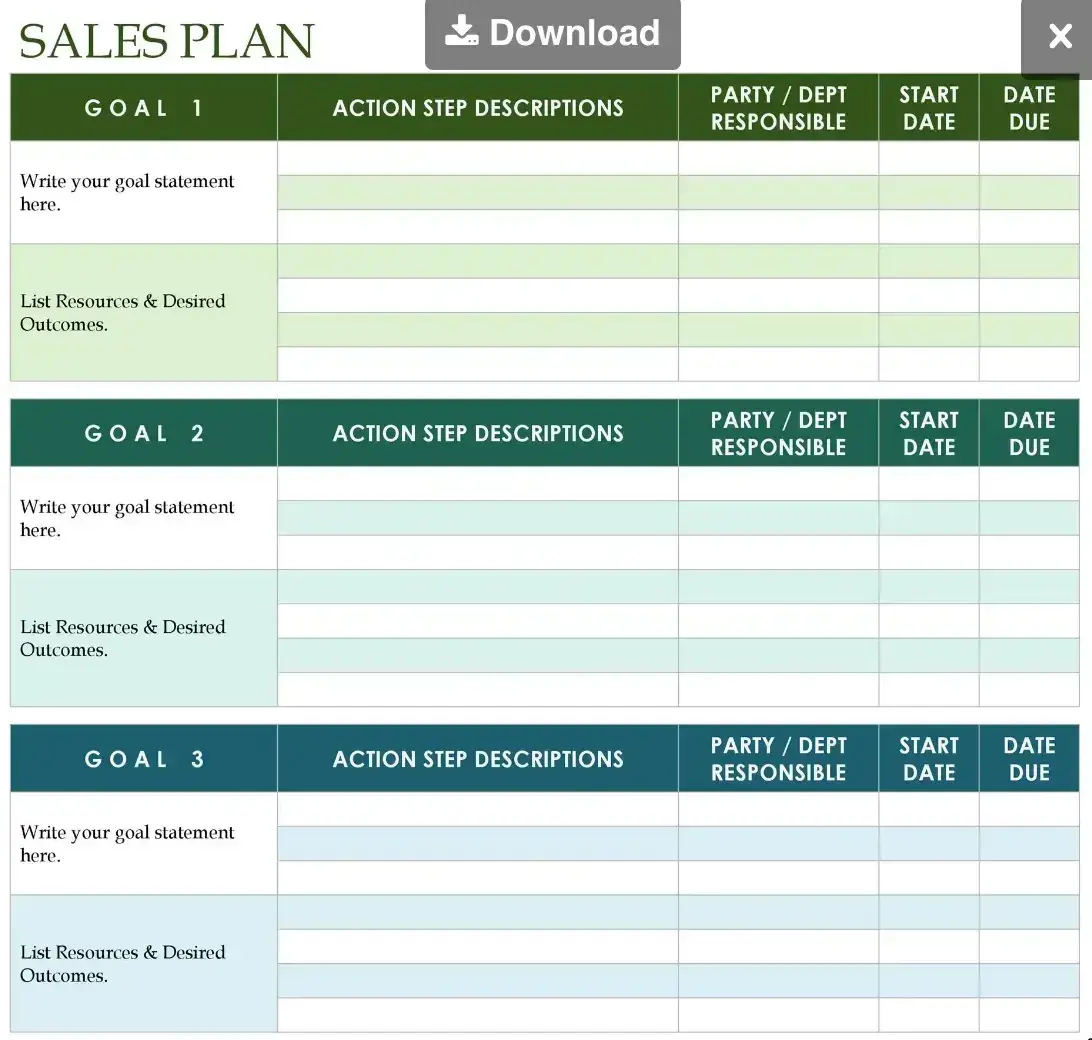
This template breaks down goals into action items, helps you think about how to assign responsibilities, and gets you to commit to specific dates.
I think the best part of this template is that it focuses on multiple goals, giving you a bird's eye view of several initiatives you may be putting together.
10. 90-Day Sales Plan by Template.Net
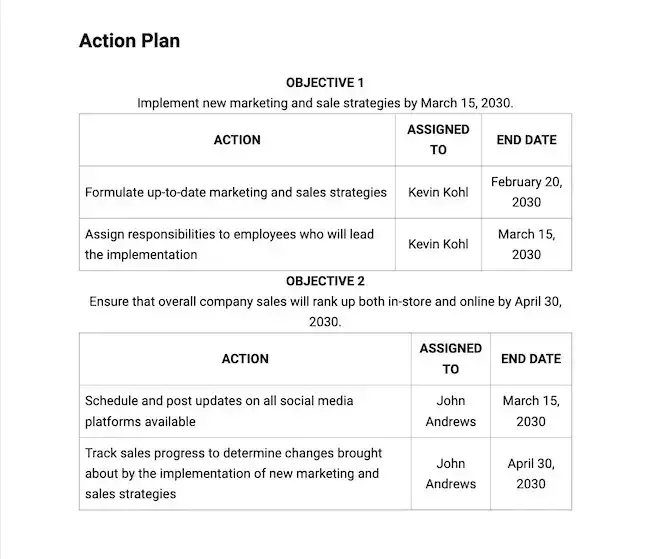
This sample sales plan will help you plan your sales strategies for the next 90 days.
It breaks your sales plan down into phases, tasks, and key questions for your sales goals. Plus, the final section is a mind map for your sales process and pipeline strategies, which is especially great for brainstorming.
Create a Sales Plan That Grows With Your Business
Here’s a tiny bit of truth that I’ll leave you with: There’s no one-size-fits-all sales plan. However, the only wrong way to use a sales plan is to write it at the start of the year or quarter and never touch it again. A static sales plan is as good as no sales plan at all.
Your market, customers, and competitors are constantly evolving, so your sales strategy should evolve, too. You should periodically review and update any sales plan you create as time goes on to ensure you (and your sales team) are focused and on track.
Set a cadence — whether it’s monthly, quarterly, or bi-annually — to assess what’s working, refine weak spots, and adjust for shifts in the industry. By continuously improving on your plan, you can ensure your company generates revenue more effectively than it ever did in the past.
The best sales teams don’t just create a plan and “hope for the best”; they treat it as a living, breathing roadmap to success. Keep refining, keep optimizing, and keep selling.
Editor's note: This post was originally published in July 2015 and has been updated for comprehensiveness.

Free Sales Plan Template
Outline your company's sales strategy in one simple, coherent sales plan.
- Target Market
- Prospecting Strategy
- Budget
- Goals
Download Free
All fields are required.




![What Is Sales? A Quick Guide [+ Examples]](https://knowledge.hubspot.com/hubfs/what-is-sales-1-20250411-8755735.webp)



![What Is Cross-Selling? Intro, Steps, and Pro Tips [+Data]](https://knowledge.hubspot.com/hubfs/ft-cross-selling.webp)



